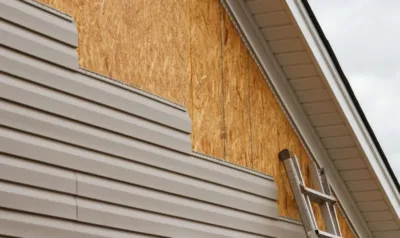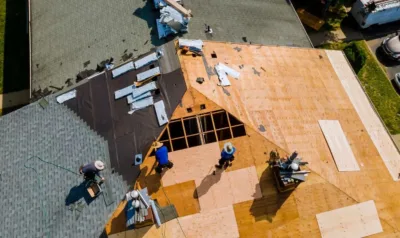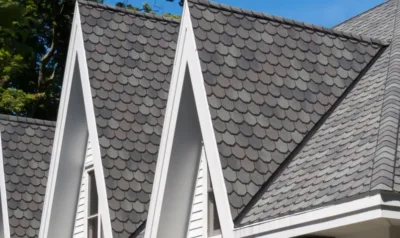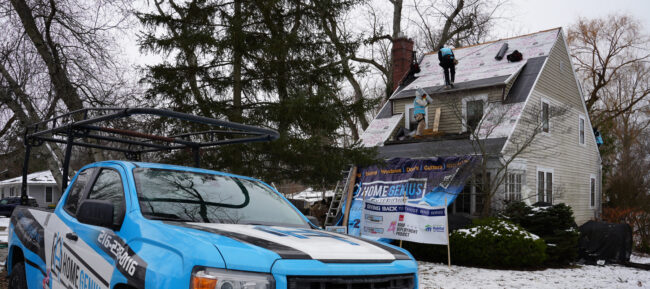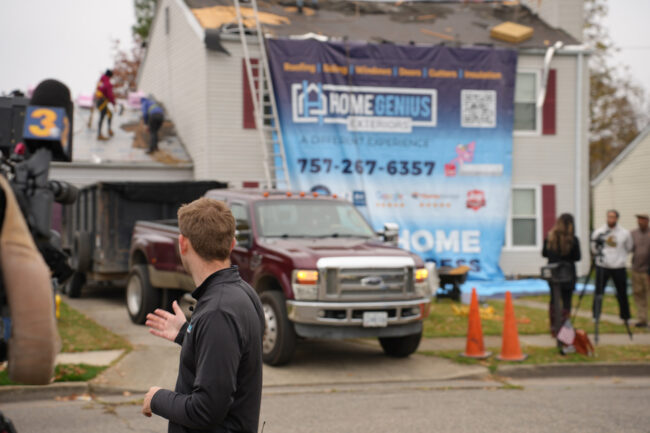What Is The Best Siding for Ohio Homes?
The best siding for Ohio Homes is fiber cement and insulated vinyl siding, the top two options for long-term protection and performance. Fiber cement offers superior durability, resistance to moisture and wind, and a high-end appearance with minimal maintenance. Insulated vinyl siding provides a cost-effective, energy-efficient solution that withstands seasonal extremes while offering a variety of styles. For Ohio homeowners, choosing one of these materials ensures reliable defense against the elements, reduced upkeep, and lasting curb appeal.

Fiber Cement Siding
Popular Brands: James Hardie
Fiber cement siding has become one of the top-performing materials for homes in Ohio. Composed of cement, sand, and cellulose fibers, it delivers outstanding strength and resilience in all types of weather.
Durability: Fiber cement is naturally resistant to cracking, warping, insect damage, moisture infiltration, and even fire. Unlike vinyl or wood, it does not expand or contract dramatically with temperature changes, making it ideal for Ohio’s freeze-thaw cycles and heavy snowfalls.
Weather Resistance: This material stands up well to rain, snow, wind, and humidity, offering reliable performance in every season. It’s especially beneficial in areas prone to strong storms like coastal regions or lake-effect snow.
Maintenance: Although not maintenance-free, fiber cement is relatively low maintenance compared to natural wood. It may need repainting every 10 to 15 years but does not require sealing or staining.
Aesthetics: Fiber cement is extremely versatile. It can mimic the appearance of wood lap siding, cedar shingles, or stucco, and it’s available in a wide variety of factory-applied colors and textures to suit traditional or contemporary homes.
Drawbacks:
- Heavier than other materials, requiring professional handling
- Higher installation costs
- Not as DIY-friendly due to its weight and cutting requirements
Best For: Homeowners seeking long-lasting performance, minimal upkeep, and a high-end appearance that withstands Ohio’s harshest climate conditions.
Vinyl Siding
Vinyl siding continues to be the most commonly installed siding material in Ohio, largely due to its affordability, easy installation, and broad availability.
Durability: Modern vinyl siding resists moisture and moderate impact, making it suitable for wet climates and neighborhoods with tree-lined lots. Newer models offer improved strength and better fade resistance.
Weather Resistance: Vinyl holds up well in rain and humidity, but it can become brittle in sub-zero temperatures and may warp under prolonged exposure to direct sunlight if not installed properly.
Maintenance: It’s one of the lowest-maintenance options available. It doesn’t need to be painted or stained and only requires occasional cleaning with soap and water.
Aesthetics: Available in a wide range of colors and styles—including wood-look finishes—vinyl can complement almost any home. Its affordability makes it a practical choice for new construction or remodeling on a budget.
Drawbacks:
- Not as impact-resistant as other materials
- Can crack in extreme cold or warp in excessive heat
- Appearance may lack the depth and texture of wood or fiber cement
Best For: Budget-conscious homeowners or those looking for a quick, low-maintenance siding solution that performs adequately in most Ohio weather conditions.
Engineered Wood Siding
Popular Brands: LP SmartSide, KWP Eco-Side
Engineered wood siding combines the natural beauty of wood with improved durability and lower maintenance needs, making it a smart choice for homeowners who love the look of traditional materials but want modern performance.
Durability: Treated to resist rot, insects, fungal decay, and moisture, engineered wood performs well through Ohio’s seasonal changes and high-humidity summers.
Weather Resistance: Designed to expand and contract less than natural wood, this material holds up better during temperature swings. It’s engineered specifically to overcome the weaknesses of traditional wood.
Maintenance: Requires less frequent maintenance than cedar or pine siding. It may need occasional repainting or resealing but doesn’t require annual treatments.
Aesthetics: Engineered wood offers a very authentic woodgrain appearance and can be customized with various finishes, board styles, and colors to match historical, craftsman, or farmhouse-style homes.
Drawbacks:
- More expensive than vinyl
- Requires protective coatings for optimal performance
- May not last as long as fiber cement or composite options
Best For: Homeowners who want the charm of wood siding without the high upkeep or susceptibility to moisture problems.
Steel and Aluminum Siding
Metal siding, particularly steel and aluminum, provides excellent strength and weather protection—especially in parts of Ohio that face frequent wind storms or hail.
Durability: Steel siding is incredibly tough and can last up to 100 years with proper maintenance. It resists pests, fire, and warping better than many other materials. Aluminum, while slightly less durable, is lightweight and corrosion-resistant.
Weather Resistance: Both materials stand up well against snow, rain, and wind. Steel is especially resilient during hailstorms, while aluminum performs better in salty or humid environments.
Maintenance: Very low maintenance. Metal siding doesn’t rot or swell, and most products have baked-on finishes that last for decades.
Drawbacks:
- Steel can rust if not properly coated or maintained in wet climates
- Aluminum is more prone to denting
- Color fading can occur over time due to sun exposure
- May require additional insulation for energy efficiency and soundproofing
Best For: Homes in storm-prone regions or those with modern or industrial designs. Also great for homeowners who want a long-term, durable investment.
Cedar and Natural Wood Siding
For those who prefer timeless charm and natural materials, cedar and other wood sidings remain a beautiful, high-end choice. Cedar is naturally resistant to rot and insect damage, making it the preferred wood option for exteriors.
Aesthetics: Offers a warm, authentic look that enhances the appearance of colonial, craftsman, and cottage-style homes. The texture and grain of real wood are unmatched by synthetic alternatives.
Insulation: Wood is a natural insulator and can help with energy efficiency, especially when combined with other insulation materials.
Sustainability: As a renewable resource, cedar is an eco-friendly option, particularly if sourced from sustainably managed forests.
Drawbacks:
- Requires regular maintenance, including sealing or painting
- Vulnerable to mold, rot, and insect damage in wet climates
- Higher lifetime costs due to upkeep and repairs
Best For: Historic properties, homeowners focused on sustainability, or those who prioritize natural aesthetics and are willing to commit to regular maintenance.
Brick, Stone Veneer, and Composite Siding
These premium materials are often used for full exteriors or accent walls in custom or luxury homes. They provide unmatched durability and visual appeal.
Brick and Stone Veneer:
- Naturally fireproof and low maintenance
- Excellent durability and resistance to weather and impact
- Adds significant value and architectural depth
Composite Siding:
- Made from a blend of wood fibers and resin
- Offers excellent weather resistance with minimal maintenance
- Designed to replicate wood textures with better longevity
Drawbacks:
- Higher initial material and labor costs
- Stone and brick are heavy and require proper structural support
- Less flexibility for retrofits unless part of the original home design
Best For: Homeowners looking to elevate curb appeal with high-end finishes that are built to last and require little attention once installed.
Comparison Table
| Siding Type | Durability | Weather Resistance | Maintenance | Cost | Best For |
| Fiber Cement | Excellent | Moisture, fire, cold | Low–Moderate | $$–$$$ | Year-round performance |
| Vinyl | Good–Very Good | Moisture, moderate impact | Very Low | $–$$ | Budget, minimal upkeep |
| Engineered Wood | Very Good | Rot, insects, temp swings | Low–Moderate | $$–$$$ | Natural look with durability |
| Metal (Steel/Alum) | Excellent | Extreme weather, fire | Low | $$–$$$ | Contemporary or rural applications |
| Cedar/Natural Wood | Good | Fair with maintenance | High | $$–$$$ | Traditional, warm appearance |
| Brick/Stone/Composite | Excellent | Wind, moisture, heat | Very Low | $$$ | High-end and accent siding |
Recommendations
Best Overall
Fiber cement siding offers the best balance of performance and appearance. It handles Ohio’s year-round weather while requiring little maintenance and delivering long-lasting protection.
Best Value
Vinyl siding is ideal for homeowners on a budget who want a low-maintenance, attractive option that holds up well against humidity and precipitation.
Best for Wood Appearance
Engineered wood siding replicates the character of real wood while offering far superior durability and weather resistance compared to traditional timber.
Best for Maximum Durability
Steel siding is one of the longest-lasting materials and stands up to everything from hailstorms to heavy snow. Just ensure it is properly treated or coated to prevent rust over time.
Best for Traditional Homes
Cedar siding and natural wood are well-suited for homeowners who appreciate natural beauty and are prepared to handle the upkeep.
Best for Accents or High-End Finishes
Brick, stone veneer, and composite siding can be used to create visually striking accents or full façades that boost curb appeal and property value.
Key Factors for Ohio Homes
Moisture and Freeze Protection
Ohio experiences frequent freeze-thaw cycles that can damage porous or poorly installed siding. Choose materials that resist moisture and are installed with proper sealing techniques.
Energy Efficiency
Insulated siding can help maintain indoor comfort and lower heating and cooling bills. Look for products with built-in foam backing or combine your siding with continuous insulation.
Longevity and Maintenance
Choose siding materials that require minimal upkeep to avoid future maintenance costs. Durable materials with weather-resistant coatings can extend the life of your siding significantly.
Professional Installation
Always hire experienced Ohio-based siding contractors who understand local climate needs and building codes. Proper installation is just as important as material quality in ensuring lasting performance.
Conclusion
The best siding for your Ohio home depends on your goals, budget, and preferences. Fiber cement offers unmatched all-weather protection, vinyl siding provides easy maintenance and affordability, and engineered wood delivers a beautiful, natural look with modern resilience. Whether you are focused on curb appeal, storm resistance, or energy efficiency, Ohio offers a variety of siding solutions to match every need.
Ready to upgrade your home’s exterior? Contact Home Genius Exteriors for expert guidance, premium siding materials, and professional installation tailored to Ohio’s demanding climate. Whether you’re considering fiber cement for its strength, vinyl for its affordability, or engineered wood for its natural charm, our team will help you choose the perfect solution for your home. Schedule your free consultation today and invest in siding that’s built to last.
